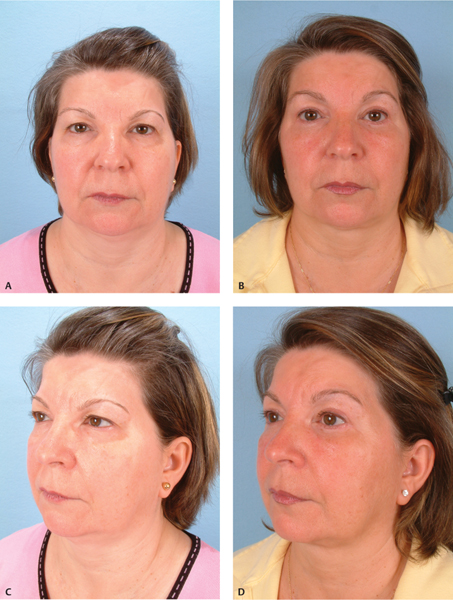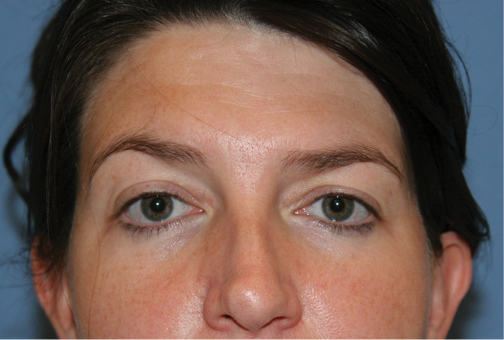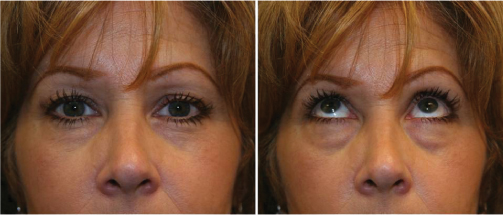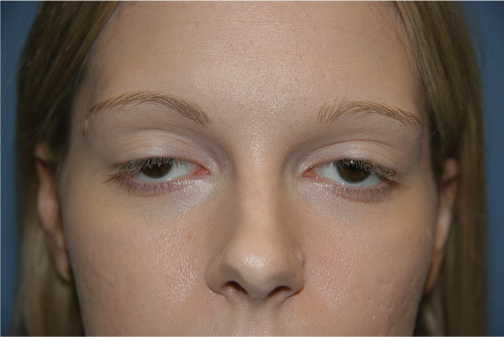9 Surgical rejuvenation of the aging brow is straightforward in principle, with primary goals being upward repositioning of the lateral brow/upper eyelid complex and reduction in brow depressor muscle activity. When the procedure is undertaken on a suitable patient, the combination of anatomically appropriate dissection and bitemporal fixation should be free from complications, easy to undergo, appear natural, improve the aesthetics of the upper face, and be pleasing to the patient (Fig. 9.1A–D). The operation itself is one of the safer cosmetic surgical procedures, typically devoid of the devastating complications that can be seen with other facial surgeries. Even so, there is no dispute over the importance of a well-performed browlift and its significant contribution to the overall appearance of the rejuvenated patient.1 In this chapter, both the potential pitfalls of contemporary endoscopic browlifting and straightforward mitigation strategies are reviewed. Modern browlifting, like many facial surgery procedures, can trace its roots to a time of human conflict when combat-related deformities were abundant, with the first description of an aesthetic foreheadplasty in 1919 by Rene Passot.2 Early emphasis was placed upon horizontal skin excisions to improve forehead furrows and lateral brow hooding, but repositioning techniques quickly emerged. These subsequent techniques described wide skin undermining, modifications to the brow depressor muscles, and eventual subgaleal dissection. By the latter half of the 20th century, descriptions of multiplanar brow dissection became commonplace, and the coronal browlift became the procedure of choice. In 1992 Isse and Vasconez introduced a minimally invasive technique of brow rejuvenation: the endoscopic foreheadplasty.3–5 Although no single procedure has proven definitively to be the best for forehead rejuvenation, the endoscopic browlift or a combination of the endoscopic and open trichophytic browlift has been widely embraced, challenging their predecessors in pursuit of the procedure of choice for brow rejuvenation.6–11 Endoscopic brow rejuvenation is the focus of this chapter. Rejuvenation of the aging brow is not complex in nature; however, there are pitfalls to avoid in the quest for the ideal result. Prevention of a bad outcome starts with appropriate patient selection and a thorough preoperative evaluation. Poor patient selection, that is, performing the wrong operation on an inappropriate patient, is often at fault. The surgeon should always strive to avoid this situation by selecting the correct operation for an appropriate patient. The prospective browlift patient should be healthy enough to undergo the proposed operation and the accompanying level of anesthesia, and it is incumbent upon the operating surgeon to discover any medical or psychiatric history that could lead to a contrary result. A history of poor wound healing, chronic steroid use, brittle diabetes mellitus, inability to lie supine, dry eyes, or frontal bone fibrous dysplasia may alter the surgical plan. A history of prior forehead surgery or injury (craniofacial trauma, frontal sinus fracture, forehead or temple skin cancer reconstruction, paramedian forehead flap, osteoplastic flap, CN VII injury, scalp avulsion or extensive laceration, or hair transplantation) may also require a change in the rejuvenation strategy. Communication with the patient’s primary care physician or consultation with a medical specialist is important if there is any doubt regarding the patient’s prior medical history. As with all surgical procedures, it is prudent to communicate any concerns regarding anesthesia (airway compromise, vocal fold motion impairment, sleep apnea, prior difficult intubation, prior cervical spine surgery, latex allergy, family history of malignant hyperthermia or pseudocholinesterase deficiency, etc.) to the anesthesiologist. In other words, always attempt to forecast obstacles from induction to recovery. It is ultimately better to refuse to perform the browlift or to alter strategy than to proceed in an unsafe or uncertain fashion. Fig. 9.1 Patient before (A, C) and after (B, D) endoscopic browlift with upper blepharoplasty. The surgeon must also openly discuss the effect that a browlift may have on the patient’s hairline. If the patient has a high hairline, forehead shortening may need to be utilized.12 Too often the forehead shortening modification is overlooked, contributing to inappropriate hairline elevation. If the patient has alopecia or pattern baldness, a standard endoscopic approach may not be indicated, and incision orientation and/or browlift technique may need to be altered (e.g., midforehead or transblepharoplasty). Spending time discussing these myriad topics during the consultation will go far to educate patients and crystallize their postoperative expectations, which will ultimately lead to enhanced patient satisfaction. The old idiom “forewarned is forearmed” is particularly appropriate with regard to cosmetic surgery, and a thorough physical examination is the surgeon’s early warning system. With the relaxed patient directly in front of the examiner, the position and shape of the eyebrows as well as the location of the hairline and status of hair pattern (using the Norwood classification for males) should be noted.13 Eyebrow position should be documented relative to the underlying bony brows. Note whether the patient exhibits exophthalmos, lateral canthal dystopia with inferior eyelid rounding, or a negative vector that might predispose him or her to exposure keratitis. Skin thickness, skin condition, alopecia, and any relevant scars should be noted. Pay particular attention to the presence of eyebrow asymmetry, blepharoptosis, and superolateral orbital hooding. Is there evidence of eyelid ptosis accompanied by compensatory brow elevation? (Fig. 9.2) Is ptosis absent, but brow asymmetry present? (Fig. 9.3) Surgeons must recognize that browlifting does not correct eyelid ptosis (Fig. 9.4), and those surgeons uncomfortable with ptosis repair should consider having an oculoplastic surgeon perform this concomitantly with the browlift. After the inspection of the patient at rest, the practitioner should perform a dynamic exam. The mobility of the soft tissue envelope and the strength of the frontalis, corrugator supercilii, procerus, and orbicularis oculi muscles should be assessed. Is there evidence of frontotemporal branch weakness, or is there skin tethering suggestive of prior trauma? Is there any evidence of forehead lipomata or cystic masses? The bony brow and the frontal skull should be palpated to ensure there are no irregularities (e.g., osteomata) that may hamper brow rejuvenation. Fig. 9.2 Illustration of right-sided ptosis with compensatory frontalis muscle hyperfunction. Fig. 9.3 Patient with right frontotemporal nerve palsy and brow asymmetry, elicited more dramatically on upward gaze. Fig. 9.4 Patient with bilateral eyelid ptosis. Photographic documentation should be performed next. Studying the patient’s preoperative photographs often provides the surgeon with additional information, as they are a good supplement to the physical examination. The images should be reviewed with the patient, and any preexisting asymmetries, ptosis, scars, alopecia, hairline position, etc. should be clearly illustrated, openly discussed, and thoroughly documented. Lastly, providing there is consent to do so, before and after photographs of other browlift patients should be reviewed with the patient. This review will help candidates for surgery to bring their expectations of benefit into better focus. As Withey et al. pointed out in their review of 100 endoscopic browlifts, no in-depth studies of the complication rates of this operation have been published.14 Even so, adverse outcomes do occur and are generally attributable to one or more of the following: (1) inappropriate surgical technique, (2) inappropriate surgical judgment, (3) inappropriate recovery, or (4) inappropriate patient expectations. Regarding expectations, patients must firmly understand that the goal of a browlift is not perfection but rather improvement that has a natural appearance. Therefore, preoperative discussion and counseling are absolute necessities. This allows prospective browlift patients to develop appropriate expectations and leads to increased satisfaction with the outcome. As indicated previously in this text, Dr. Eugene Kern advises that preoperative preparation should be taken a step further, by preparing the patient for a second operation (i.e., revision) before performance of the first.15 Problems in recovery are avoided with prudent patient selection and careful postoperative care, while solid surgical experience and careful preparation will help the surgeon avoid perturbations in judgment (for example, doing an endobrowlift without the forehead lowering modification in a patient already self-conscious about a high hairline). Errors or inadequacies in browlift technique, which are myriad and are similarly minimized with impeccable training and increased experience with the operations, are the focus of the rest of this chapter (Table 9.1). In surgical brow repositioning, injury to the frontotemporal branches of the facial nerve is a serious concern; although it has not been definitively defined in the literature, its incidence is estimated at 3–5% (both transient and permanent cases). The surgeon can protect the frontotemporal branches and preserve the motion of the frontalis muscle by understanding the anatomy in this area.16 After the main trunk of the facial nerve exits the stylomastoid foramen, the frontotemporal branch fibers depart the pes anserinus, coursing superiorly through the parotid gland and over the zygomatic arch, ultimately sending motor fibers to synapse with the frontalis and orbicularis oculi muscles (Fig. 9.5).
Prevention and Management of Adverse Outcomes in Brow Rejuvenation
 A Brief History
A Brief History
 Patient Selection and General Considerations
Patient Selection and General Considerations
The Brow Exam
 Browlift Pitfalls
Browlift Pitfalls
Facial Nerve Injury
Stay updated, free articles. Join our Telegram channel

Full access? Get Clinical Tree







